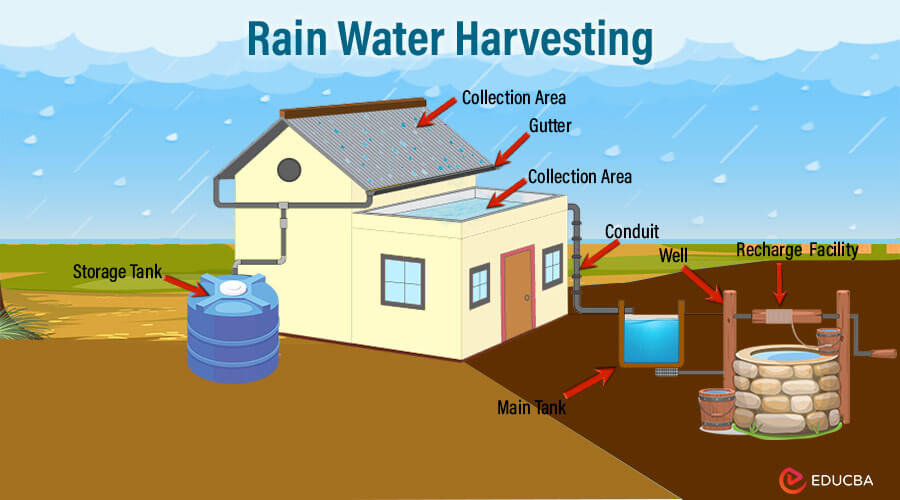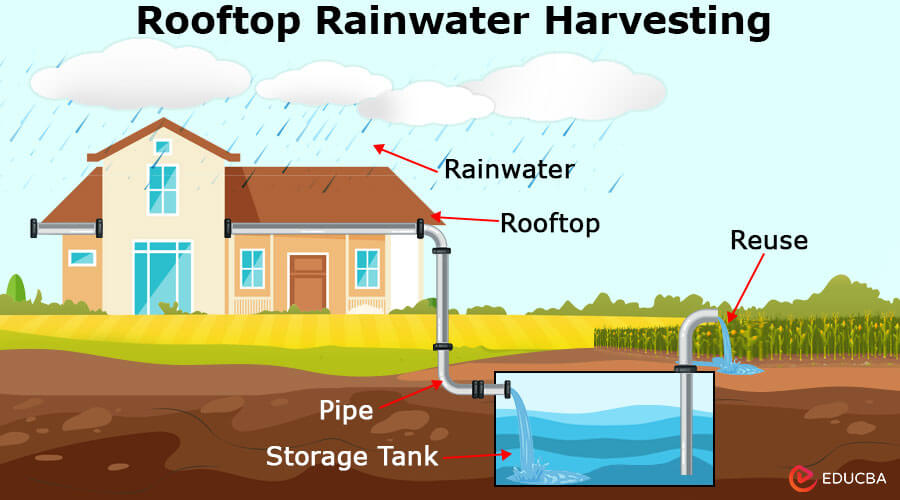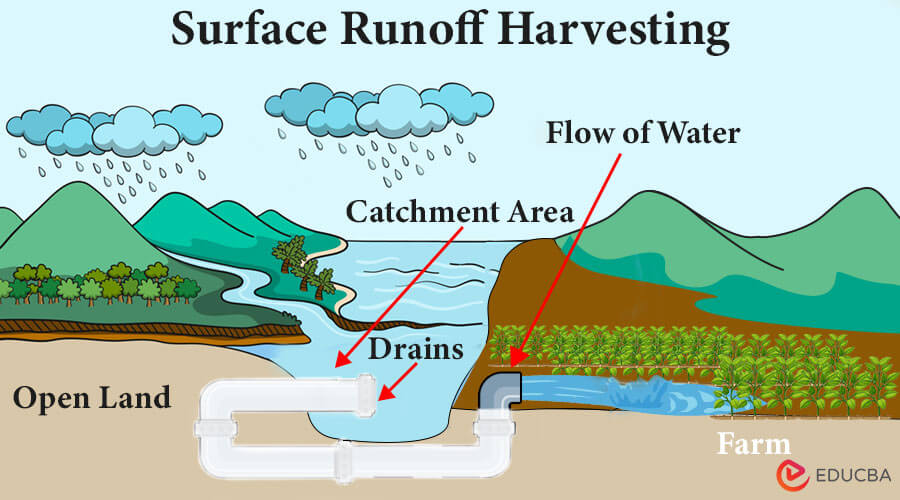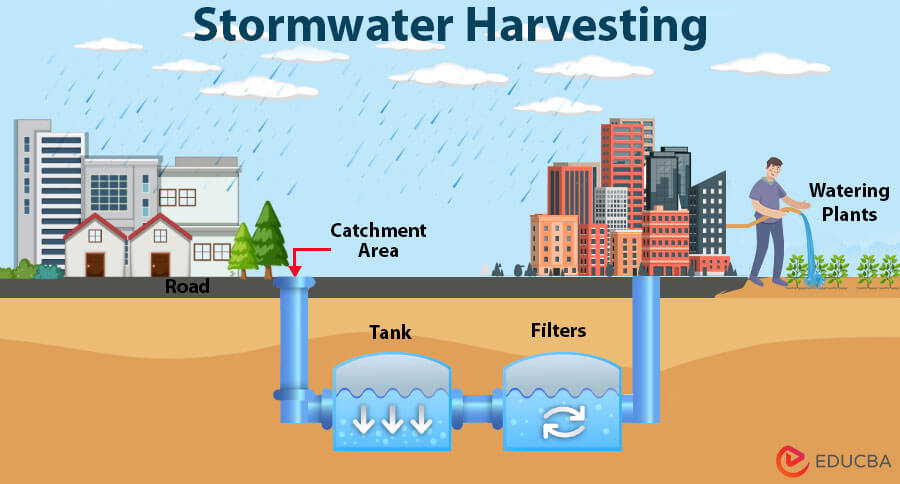Definition
Gathering and storing rainwater for future use is known as rainwater harvesting. It involves the capture of rainwater from surfaces like rooftops, roads, or open grounds, directing it to storage facilities, and utilizing it for various purposes such as irrigation, domestic use, and groundwater recharge. This sustainable practice reduces dependence on conventional water sources, mitigates flooding, and contributes to conservation efforts.

The Need for Rainwater Harvesting
The need for rainwater harvesting has become increasingly evident in the face of growing challenges related to water scarcity, depleting groundwater resources, and the expanding demand for water in various sectors. Here are some key points highlighting the pressing need for rainwater harvesting:
1. Global Water Scarcity
- Many regions worldwide are grappling with water scarcity, exacerbated by climate change, population growth, and inefficient water management practices.
- Rainwater harvesting provides an additional sustainable water source, helping alleviate the pressure on traditional water supplies.
2. Depleting Groundwater Resources
- Over-extraction of groundwater for agriculture, industry, and domestic use has led to declining water tables in numerous areas.
- Rainwater harvesting helps recharge groundwater aquifers by capturing rainwater and allowing it to percolate into the ground, replenishing underground reservoirs.
3. Urbanization and Increased Water Demand
- Rapid urbanization has expanded impervious surfaces like roads and buildings, reducing natural infiltration and increasing surface runoff during rain events.
- Rainwater harvesting in urban areas helps manage stormwater, prevent flooding, and ensure a local, decentralized water supply to meet the rising demands of urban populations.
4. Mitigating the Impact of Drought
- Rainwater harvesting is crucial for building resilience against prolonged dry periods in drought-prone regions.
- Stored rainwater can be used during periods of low precipitation, providing a reliable water source for agriculture, domestic use, and other essential needs.
5. Conservation of Ecosystems
- Uncontrolled runoff during heavy rains can lead to soil erosion, loss of topsoil, and degradation of ecosystems.
- Rainwater harvesting reduces runoff, preventing soil erosion and maintaining the health of ecosystems by allowing water to be absorbed naturally into the ground.
6. Energy and Cost Savings
- Traditional water supply systems, such as pumping water from distant sources, can be energy-intensive and costly.
- Rainwater harvesting promotes a decentralized water supply, reducing the need for extensive distribution networks and the associated energy costs.
Components of Rainwater Harvesting Systems
Here’s an explanation of each component in detail:
1. Catchment Area: The catchment area is the surface from which rainwater is collected. It typically includes rooftops, pavements, and other impervious surfaces.
- Description: Rainwater is collected as it falls on these surfaces. Rooftops are particularly effective catchment areas as they provide a clean and easily accessible surface for water collection. The choice of catchment area material is essential to ensure water quality, as contaminants from the catchment surface can affect the harvested water.
2. Conveyance System: The conveyance system consists of gutters, downspouts, and pipes transporting rainwater from the catchment area to the storage or infiltration system.
- Description: Gutters and downspouts collect rainwater from the catchment area and direct it to the storage or treatment facility. Proper design and installation of the conveyance system are crucial to minimize water losses and ensure the efficient transfer of rainwater.
3. First Flush Diverters: First flush diverters divert the initial portion of rainwater, which may contain contaminants from the catchment surface, away from the storage system.
- Description: The first flush of rainwater often contains debris, dust, and pollutants washed off from the catchment area. First flush diverters help improve the quality of harvested rainwater by directing this initial runoff away, ensuring that cleaner water enters the storage or treatment system.
4. Filter and Treatment Units: Filter and treatment units remove impurities, debris, and contaminants from harvested rainwater.
- Description: Various filtration and treatment methods are employed to enhance the quality of harvested rainwater. Common treatments include mesh filters, sedimentation tanks, and disinfection processes such as UV treatment or chlorination. These units ensure the stored water is safe for various uses, including drinking and irrigation.
5. Storage Facilities: Storage facilities include tanks, cisterns, or underground reservoirs where harvested rainwater is stored for later use.
- Description: The size and type of storage facility depend on the demand for water and the frequency and intensity of rainfall. Adequate storage capacity is essential to meet water needs during dry periods or when rainwater is unavailable. Tanks may be made of plastic, concrete, or metal, with proper sealing to prevent contamination.
6. Distribution System: The system comprises pipes and pumps that convey stored rainwater to use points.
- Description: For rainwater to be effectively utilized, a distribution network must transport the water from storage to various locations within a building or community. Pumps may be necessary to provide the required pressure for distribution, especially in larger systems or where uphill transport is needed.
7. Overflow System: The overflow system directs excess rainwater away from the storage facility when it reaches capacity.
- Description: An overflow system is essential to prevent flooding or damage to the storage system. This directs excess rainwater to appropriate drainage, ensuring that the storage facility remains functional and that excess water is safely managed.
How to Harvest the Rainwater
Harvesting rainwater involves a systematic approach to capturing, conveying, and storing rainwater for various purposes. Here’s a detailed, step-by-step guide on how to harvest rainwater:
- Assessment and Planning: Start by evaluating your land to see if rainwater collection is a viable option. Consider factors such as roof area, rainfall patterns, and local regulations. Plan the system based on your water needs and the available space.
- Calculate Catchment Area: Measure the roof area that will serve as the catchment surface. The size of the catchment area will influence the amount of rainwater you can harvest. Ensure that the roofing material is suitable for rainwater collection.
- Install Gutters and Downspouts: To collect rainwater, install gutters around the borders of the roof. Connect the downspouts to direct water from the gutters into the storage system. Ensure that the gutters are correctly sloped for efficient water flow.
- Leaf Screens and First Flush Diverters: Install leaf screens in the gutters to prevent debris from entering the system. Consider adding first flush diverters to redirect the initial runoff, which may contain contaminants, away from the storage tank.
- Conveyance System: Use PVC pipes or other suitable conduits to transport rainwater from the downspouts to the storage tank. Ensure proper sizing and slope to facilitate smooth water flow.
- Storage Tank Installation: Choose an appropriate storage tank based on your water requirements and available space. Install the tank on a stable and level base. Connect the conveyance system to the inlet of the tank.
- Filtration and Treatment: To clean the collected rainwater of contaminants and silt, install a filter system. Consider implementing treatment techniques like UV sterilization or chlorination depending on the need for water quality.
- Overflow System: Set up an overflow system to redirect excess water from the storage tank during heavy rainfall. This prevents flooding and potential damage to the harvesting system.
- Distribution System (Optional): Install a distribution system if the harvested rainwater will be used for domestic or irrigation purposes. Use pipes to convey water from the storage tank to the use points. Include a pump if necessary for pressurized distribution.
- Monitoring and Control Systems: Implement sensors and control devices to monitor water levels and system performance and, if applicable, automate control functions. This enhances the efficiency and reliability of the rainwater harvesting system.
- Maintenance Access: Incorporate access points, such as hatches or openings, to facilitate regular maintenance activities. Schedule routine checks for cleaning, inspection, and repairs to ensure the system’s optimal performance.
- Educate and Promote Awareness: Raise awareness among household members or the community about the benefits of rainwater harvesting. Encourage responsible water use and share information on the system’s operation and maintenance.
Types of Rainwater Harvesting
Here are three common types of rainwater harvesting:
1. Rooftop Rainwater Harvesting
- Description: In this method, people collect rainwater directly from rooftops and convey it to storage tanks for later use.
- Components: The catchment area is the roof surface, and the conveyance system includes gutters and downspouts that direct rainwater to storage tanks. You can use first-flush diverters and filters to improve water quality.
- Advantages: Easy to use and reasonably priced, particularly for single homes. It takes up very little room and is simple to incorporate into already-built structures.
2. Surface Runoff Harvesting
- Description: Surface runoff harvesting involves collecting rainwater from open ground surfaces, such as roads, pavements, and open fields.
- Components: The catchment area comprises the ground surface, and channels, drains, or trenches collect rainwater. We can direct the collected water to storage tanks or use it to recharge groundwater.
- Advantages: Suitable for areas with limited roof space or where rooftops are not viable catchment areas. It can help mitigate surface runoff, reduce soil erosion, and recharge groundwater.
3. Stormwater Harvesting
- Description: Stormwater harvesting is the sustainable management of rainwater runoff from urban surfaces during heavy rainfall. The objective is to reduce urban flooding and supplement water supply.
- Components: Stormwater harvesting in urban areas involves collecting rainwater from streets, parking lots, and pavements. Conveyance systems direct water to storage facilities, like tanks, designed for subsequent use. Filtration systems enhance water quality, creating a comprehensive solution for flood control and water resource augmentation.
- Advantages: Reduces urban flooding by capturing excess stormwater runoff, preventing inundation of streets and properties. Alleviates strain on municipal drainage systems, reducing the risk of infrastructure damage.
Case Studies
Here are summaries of two case studies showcasing successful implementations of rainwater harvesting:
1. Singapore’s Public Housing Board (HDB) Rainwater Harvesting System
- Background: Singapore, facing limited freshwater resources and rapid urbanization, implemented rainwater harvesting systems in public housing estates managed by the Housing and Development Board (HDB).
- Implementation: HDB integrated rainwater harvesting into the design of new public housing blocks. Rooftop catchment areas were optimized, and a network of gutters and downspouts directed rainwater to storage tanks located within the buildings.
- Storage and Filtration: Underground storage tanks with large capacities were installed to collect and store rainwater. Filtration systems ensured the harvested water met quality standards for non-potable uses.
- Reuse Applications: Rainwater collection is employed for non-potable uses, like toilet flushing, plant watering, and communal area cleaning. As a result, there is less demand for the municipal water supply for these operations.
- Results: The rainwater harvesting systems in HDB estates contribute to water conservation efforts, reduce dependency on imported water, and demonstrate the feasibility of large-scale urban rainwater harvesting initiatives.
2. The ArRain Project in Rajasthan, India
- Background: Rajasthan, a semi-arid region in India, faced chronic water scarcity and drought conditions.The ArRain project aimed to alleviate water stress in rural communities by implementing rainwater harvesting systems.
- Implementation: The project focused on community engagement, educating residents about the benefits of rainwater harvesting. People identified the rooftops of homes and community buildings as catchment areas and constructed rainwater harvesting structures.
- Traditional Techniques: Besides modern rainwater harvesting techniques, the project incorporated check dams, contour trenches, and percolation pits to enhance groundwater recharge and soil moisture retention.
- Community Participation: The success of the ArRain project was attributed to active community involvement. Residents participated in constructing and maintaining rainwater harvesting structures, fostering a sense of ownership and sustainability.
- Impact: The project resulted in increased water availability for agriculture, improved groundwater levels, and enhanced resilience to drought. Communities experienced reduced dependence on distant water sources and improved overall water security.
Challenges and Solutions
Below are detailed insights into some common challenges associated with rainwater harvesting and potential solutions:
1. Inadequate Catchment Area
- Challenge: Small or unsuitable catchment areas limit the amount of rainwater that can be harvested.
- Solution: Optimize existing catchment areas or explore additional surfaces for rainwater collection. Ensure the compatibility of roofing materials for efficient water runoff.
2. Poor Water Quality
- Challenge: Contaminants such as leaves, debris, and pollutants may enter the harvesting system, affecting water quality.
- Solution: Install leaf screens, first flush diverters, and effective filtration systems to remove impurities. Regular maintenance is crucial to ensure continued water quality.
3. Storage Capacity Limitations
- Challenge: Limited storage capacity may lead to overflow during heavy rainfall, wasting potential harvest.
- Solution: Assess water demand and install appropriately sized storage tanks. Implement an effective overflow system to manage excess water and prevent flooding.
4. Seasonal Variability
- Challenge: Rainfall patterns can vary seasonally, affecting the consistency of water supply.
- Solution: Implement complementary strategies such as groundwater recharge during the rainy season or explore alternative water sources to supplement seasonal variations.
5. Lack of Awareness
- Challenge: Communities may need more awareness of the benefits of rainwater harvesting or clarification about its effectiveness.
- Solution: Conduct awareness campaigns, workshops, and educational programs to inform communities about the advantages of rainwater harvesting and its positive impact on water availability.
6. Ownership and Maintenance Issues
- Challenge: Lack of community involvement may result in neglect and poor maintenance of rainwater harvesting systems.
- Solution: Participate in the development, execution, and upkeep of the project with the community to cultivate a sense of ownership. Create community groups or educational initiatives to maintain the system.
7. Financial Constraints
- Challenge: High initial costs for implementing rainwater harvesting systems may discourage adoption, especially in economically disadvantaged areas.
- Solution: Explore financial incentives, subsidies, or low-interest loans to make rainwater harvesting systems more accessible. Encourage partnerships with NGOs or private entities for funding support.
Conclusion
Rainwater harvesting stands as a vital solution for global water sustainability. With technological advancements, policy support, and increasing awareness, the future holds promising prospects. As communities worldwide face growing water challenges, embracing rainwater harvesting mitigates water scarcity and aligns with broader climate resilience and sustainable development goals. The journey towards a water-secure future relies on the continued adoption and optimization of rainwater harvesting practices.



